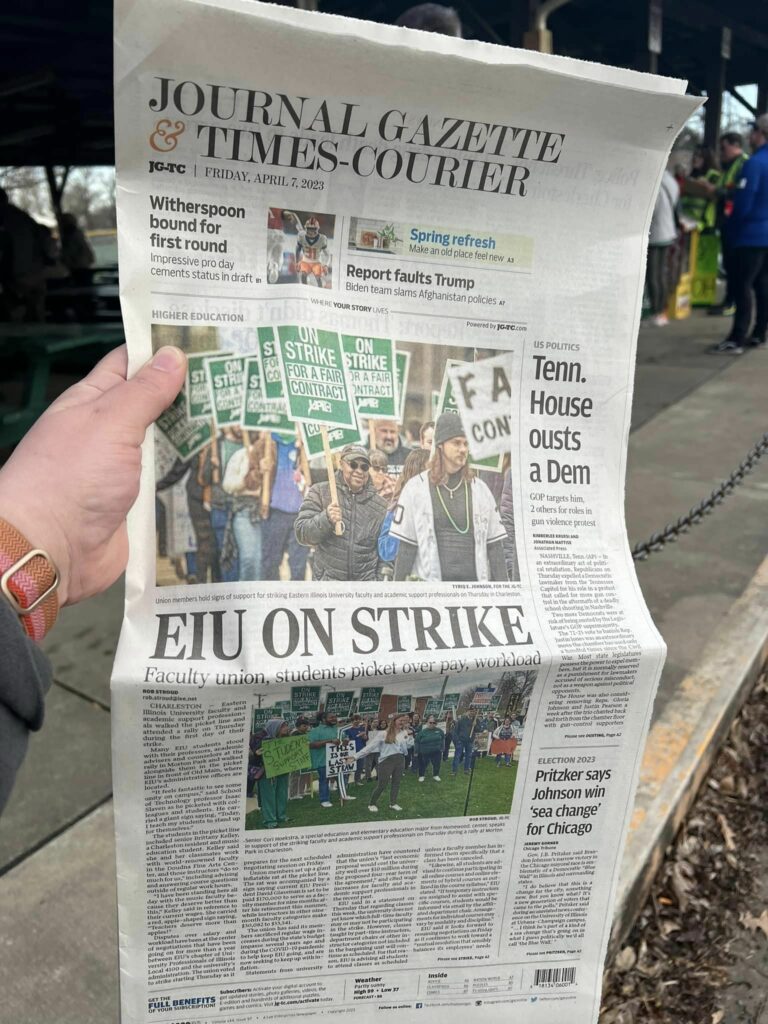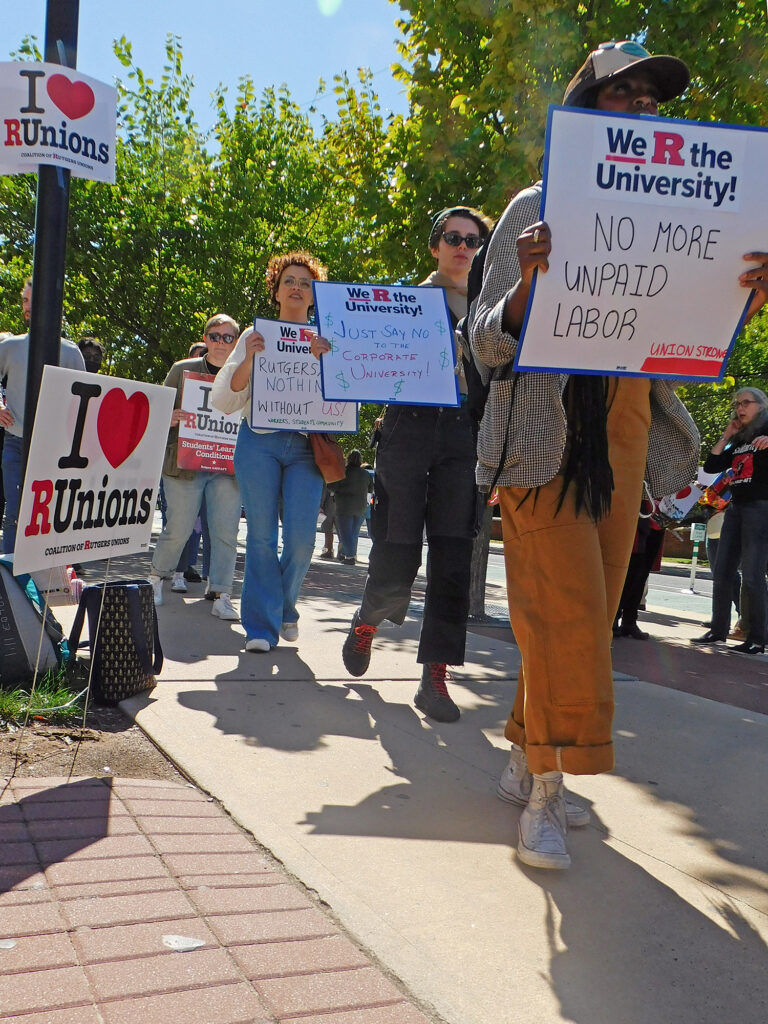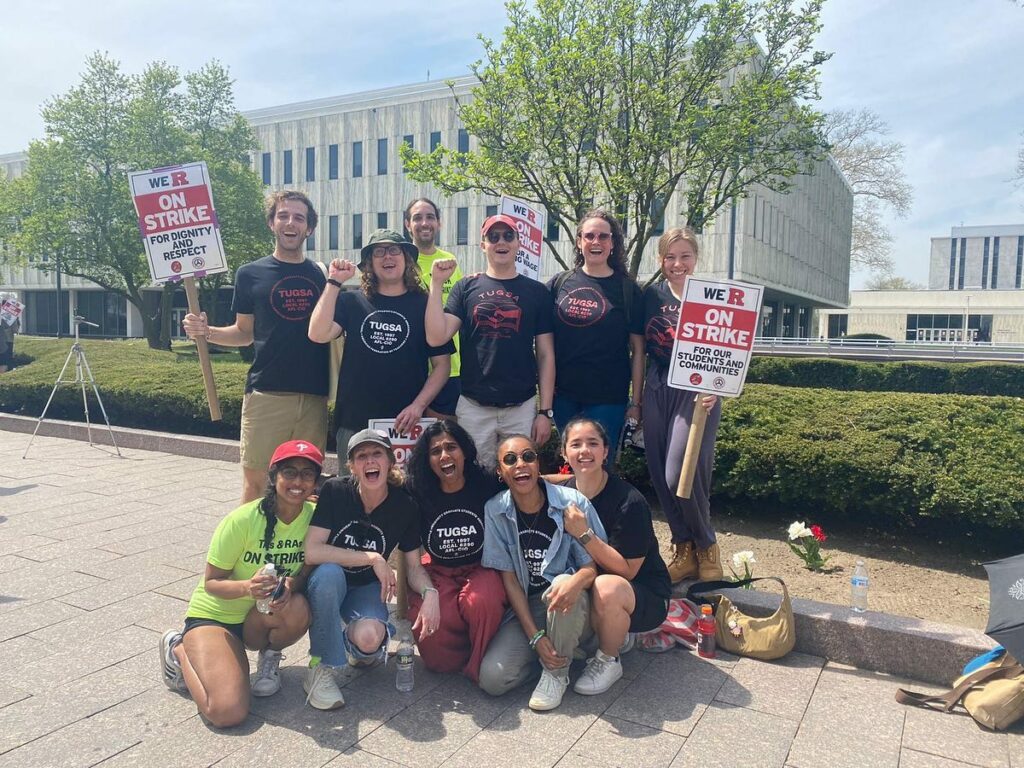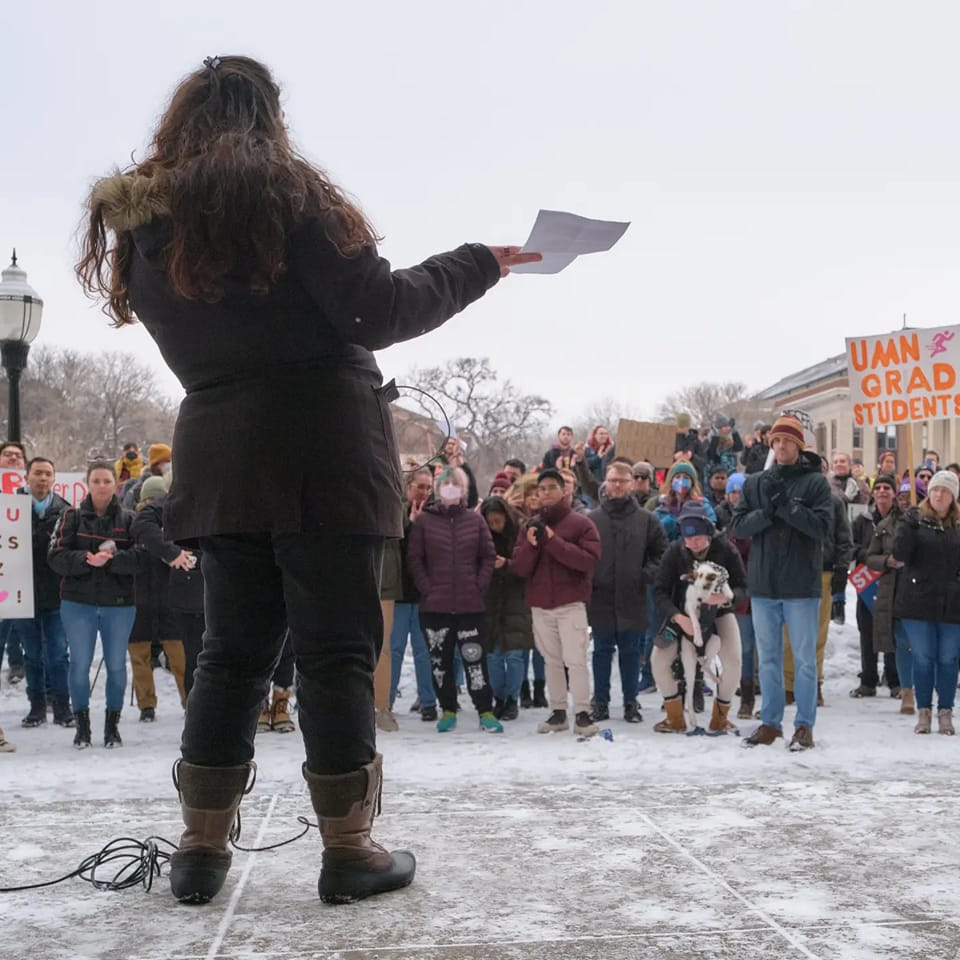Get ready for a fiery fall
Building on the year’s academic labor fights

Higher education is undergoing a “post-pandemic” organizing and strike wave. The wave of strikes and organizing campaigns have been sparked by outrage at enormous funding cuts, administrative bloat and the enrichment of university presidents and other high-level administrators, the elimination of liberal arts programs and DEI initiatives, massive rates of student debt, workload creep (and, during the pandemic, worse), adjunct precarity, and depressed wages for faculty across the board.
The fall of 2022 witnessed 17 strikes among higher education faculty and graduate students, and no fewer than 15 during the spring of 2023. Most of these actions resulted in significant gains, showing that academics can fight and win higher pay for faculty, security for contingent employees, and fellowships and other support for graduate workers.
The context of these efforts includes slashes to public university funding and the increasingly corporate priorities of even ostensibly public universities and their administrators.
Key to faculty and graduate student organizing has been the capacity of organized university workers to reach across traditional divides among full-time, tenured and tenure-track faculty, part-time contingent faculty—who teach well more than half of all students at most universities—and graduate employees. Undergraduate involvement has been a source of strength as well.
In the past, administrators were able to convince these categories of workers that they had divergent interests, with full-time faculty benefiting from the labor of adjuncts and graduate students and contingent faculty feeling exploited by their more secure peers. While each group does have some specific needs and priorities, administrators, who effectively use such differences to divide and conquer our campuses, are the ultimate beneficiaries.
The recent wave of labor activity on campuses has challenged those divisions and shown the power of solidarity. In this article, I review the events of 2022-2023 to show that there is significant cause for confidence moving into the new academic year for academic workers of all ranks. The article covers faculty and graduate student strikes and graduate student organizing drives to draw lessons for effective struggle.
Consider the following timeline:
2022 strikes and actions
New School Adjunct Strike, November 16-December 9, 2022
Part-time faculty, organized in the United Auto Workers, at the New School in New York struck on November 16. Ninety percent of faculty there are adjuncts (part-time, contingent faculty), so the strike effectively shut down the campus. This was their first strike in the University’s history and to date the longest adjunct strike in the United States.
As Teen Vogue (that bastion of progressive journalism) reported, Undergraduate support was crucial to their effort. During one march, students sang “Solidarity Forever” as they marched into and occupied the University Center on December 8. Undergraduates pay as much as $79 thousand per year in tuition and fees; very little of that amount went to supporting part-time faculty. Students vowed to continue their occupation until the administration offered higher pay, health care, and retirement benefits to all striking employees. Up to this point, in one of the most expensive regions in the country, these faculty were paid only $4300 per course, poverty wages that are substandard even for adjunct pay in general.
Ironically, the New School was founded in 1919 as a progressive institution influenced by the ideas of pragmatist John Dewey.
At the New School, the student-led student-faculty solidarity group aimed to transform the university structurally, urging pay raises, issuing no-confidence votes in the university administration, and coming out against austerity and layoffs.
After striking until December 9, the faculty overall won a pay raise of 13 percent over three years; some of the most underpaid saw a raise of 31 percent. These raises came after the University’s initial offer of a paltry 1.5 percent. In addition, a post-strike coalition was formed to establish a cooperative university. They founded a community center that provided art supplies, books, food, office supplies, essentials like tampons and condoms, and community lunches. New courses about the struggle, such as one called “Spaces of Struggle,” were created in the wake of the strike.
University of California Graduate Student Strike, November 7-December 23, 2022
In a historic act and the largest U.S. labor action in 2022, 48 thousand UAW-organized graduate workers—teaching assistants, researchers, and tutors—struck for six weeks across ten campuses. One key issue was the high cost of housing.
The strike disrupted classes and exams and basically ground all university life to a halt as “thousands formed picket lines and staged noisy protests to demand better pay.”
In a landmark deal, the graduate workers won raises from $22 thousand to $35 thousand per year. Their low pay had resulted in thousands of graduate workers ending up in grinding debt. The wage increases amounted to up to 66 percent over the two-and-a-half-year contract.
While the contract fell short of what some organizers hoped for, it was a significant victory. Rutgers professor and organizer Todd Wolfson commented about the California strike, “The strike is absolutely an object lesson and it mobilizes people. It’s part of the larger wave of worker militancy that’s impacting higher education.”
University of California doctoral student Rafael Jaime, president of UAW 2865, observed,
These agreements redefine what is possible in terms of how universities support their workers, who are the backbone of their research and education enterprise … They ultimately paved the way for the now-ratified contract … organizing students in solidarity with unionized workers on campus.
Other 2022 strikes included a four-week strike in April at Indiana University, leading to an agreement with a number of reforms benefiting graduate workers. At Columbia University, a deal reached on January 2 after a ten-week strike by student workers in fall 2021 won a six percent raise.
2023 academic labor actions
University of Michigan graduate workers strike beginning March 29, 2023
23 thousand graduate students in the Graduate Employees’ Organization at the University of Michigan in Ann Arbor struck through the end of the semester, forcing administrators and faculty to issue falsified grades to their students. Now suspended with the possibility of additional action this fall, the strike won $38 thousand for graduate students, support for international students, services for students with disabilities, and stronger sexual harassment protections.
A Jacobin article in May interviewed graduate student union contract committee chair Amir Fleischmann on the cost-of-living crisis faced by graduate students:
We’ve been on strike since March 29, making this the longest strike in our union’s forty-nine-year history. We’ve seen the gap between our salaries and the cost of living triple over the past three years. At the same time, administrators at the university are raking in gigantic salaries upward of half a million dollars a year and, for the president, actually reaching $1 million a year.
Fleischmann also spoke to the Guardian:
Many of us are struggling. We are on strike for a better university. This is a public institution that is supposed to serve the public. We’re putting forward a vision of this university where no matter your economic class, no matter your social identity, you will come here and thrive as a graduate student.
The graduate workers at Michigan are still on strike. Find out more.
Strike wave in Illinois, Spring 2023
The state of Illinois was a hotbed of academic labor struggles in the spring. In January, unionized faculty, including tenure-track and part-time contingent workers, at the University of Illinois Chicago struck for six days; the eight hundred faculty at the University of Illinois, Chicago, UIC United Faculty (AAUP-IFT) had been bargaining since the previous April. They won a contract in early February that increased starting salaries for non-tenured faculty from $51 thousand to $60 thousand. Starting salaries for tenured faculty will move from $65 thousand to $71 thousand, Williams said. All union members will receive a $2,500 raise to adjust for inflation over the past year.

Meanwhile, graduate students who work at UIC won a three-year contract after a separate strike in April. These victories at UIC paved the way for an unprecedented eruption of labor struggle across the state.
Faculty and administrative staff at Chicago State University struck from April 3 to April 13, demanding faculty raises, a reduction in faculty workload, paid family leave, and release time.
Chicago State is a regional institution serving significant numbers of low-income students and students of color. Part of the context of this strike is the major cuts in funding for Illinois public universities—by half, a cut of $1.8 billion between 2000 and 2023. Tuition rose during that time by 115 percent, a rate seven times higher than statewide income growth on average. Meanwhile, the university president made $395 thousand.
From April 6 to April 12, 450 faculty at Eastern Illinois University in the Illinois Federation of Teachers/AFL-CIO (the same union that organizes Chicago State) struck over pay and increased workload. From April 13 to April 18, faculty struck at Governors’ State University.
A strike at Northeastern Illinois University was averted in May with an agreement including pay raises and bonuses, balanced workloads, and retroactive merit pay.
Rutgers University Strike, April 10-17, 2023
The weeklong strike at Rutgers University in April was perhaps the most significant of spring 2023 strikes in terms of both inter-rank solidarity and gains won. As I reported in an earlier Tempest article, nine thousand educators walked out on April 10, beginning a week-long action that affected 67 thousand students. New Jersey Governor Phil Murphy immediately got involved and called both sides to bargain at the state capitol, giving the bargaining teams 48 hours to come to an understanding that could end the strike. It took five days and tens of millions of dollars in contributions from the governor to reach a framework for a tentative agreement.
The tentative framework that resulted contained agreements on several key issues. Graduate students won a significant pay increase to $40 thousand by 2025-2026; graduate fellows would be part of the bargaining unit as workers, giving them access to faculty health care and other protections. Part-time lecturers would receive a 43.7 percent increase in per-credit pay; full-time faculty won more raises of 3.5-3.75 percent per year, and postdoctoral scholars won large raises over the course of the contract. (While biomedical faculty also will see significant raises, the contract win did not include the family leave and workload reductions they sought.)
The University agreed to provide non-tenure-track faculty presumptively renewable five-year contracts. Under this framework, part-time lecturers would work on two-semester contracts, whereas previously, they had to re-apply to teach courses on a per-course basis every semester; more senior adjunct faculty are now eligible for 4-semester contracts. Undergraduates would benefit from this framework, which eliminates the practice of barring students from enrollment, receipt of transcripts, and graduation due to outstanding library fines and other fees.
In addition, the contract includes community demands connected to Bargaining for the Common Good, a coalition of unions and community organizations addressing issues of racism and poverty. The framework allocates $600 thousand to a “Beloved Community Fund” to help communities in need.

After five days of negotiating, the bargaining committees for the unions and the University administration tentatively agreed to the framework and the unions suspended the strike. This decision met with some controversy, especially among graduate students who wanted to continue the strike in order to win several more demands, including guaranteed fifth-year funding. Building solidarity broadly across these lines remains difficult and yet imperative.
Key to the success of this strike was the fact that the Rutgers AAUP-AFT had been building a union characterized by intersectional commitments to race and gender justice and “wall-to-wall” industrial-style organizing that united faculty at all ranks: graduate students, postdoctoral fellows, counselors, and other staff, campus, and health care workers. AAUP-AFT leader Deepa Kumar explained,
We set out to make visible these invisible workers and shed light on their conditions of labor. We showed that solidarity for us was not simply something that exists in a moral realm, but that materially we lose if we don’t stand with adjunct faculty. Tenured and tenure-track faculty are also very invested in good graduate programs because if you don’t have good funding, you lose people to competing research-one universities.
Kumar added, “Over the last decade we have made arguments that show that we are all in this together. We brought back an old labor slogan: ‘An injury to one is an injury to all.’”
Undergraduate solidarity was also very important. The unions took up student demands around unpaid fees, withholding transcripts for students who have outstanding balances, and other measures. The strike took up the slogan: “Our working conditions are our students’ learning conditions.”
Other spring 2023 strikes
Other spring 2023 strikes included one beginning January 31 and lasting a month at Temple University of seven hundred graduate workers, which won a contract including thousands of dollars of raises and other benefits. The Fordham University Graduate Student Workers Union (CWA 1104) staged a three-day walkout (after eight months of bargaining) in April for pay increases, support for housing, support for international students, child care subsidies, and other reforms. The University capitulated.

image: https://www.facebook.com/OurTUGSA/photos/pb.100048795445414.-2207520000./3447833455463597/?type=3
Graduate organizing drives
These strikes and their gains are impressive and unprecedented in the history of higher education in the United States. Equally as impressive are the numbers and strengths of graduate student organizing drives, which have resulted in the recognition of more than twenty unions organizing graduate workers to exert their collective power.
At Yale, four thousand graduate students won their union vote in April 2023. At Northwestern University, graduate students voted to organize with United Electrical Workers (UE) in January. The University of Southern California Graduate Student Workers Organizing Committee began contract negotiations with their administration in April. Worcester Polytechnic graduate workers organized and bargained successfully for raises.
At the University of Chicago in March, the Graduate Student Union-UE won its election in a landslide and now represents more than three thousand graduate workers. In March, 2023, their organization pressured the university, without a strike, to increase base stipends for graduate students from $37 thousand to $40 thousand. Graduate students at MIT are building toward a union and bargaining with their administration which so far has denied them union recognition.
At Brown, Johns Hopkins, Princeton, Duke, Dartmouth, and the University of Minnesota the story is the same: Graduate student workers are coming into their own as a powerful constituency at the universities that depend on their labor.
Recent high-profile union wins include the Minnesota victory, graduate workers at Northwestern University and Duke University—encompassing about seven thousand Ph.D. students combined.

Writing in Labor Notes, Economic Policy Institute coordinator Dave Kamper reports that across six graduate union elections (Minnesota, Boston University, Yale, Northwestern, Johns Hopkins, and Chicago), 10,266 workers voted yes and only 65 voted no—meaning that in bargaining units representing 19 thousand workers, 94 percent of them favored unionization.
Writing for the Brown Daily Herald, Katie Jain quotes Logan Mann, a Dartmouth graduate student leader: “The future is looking really, really bright for grad student workers.”
Conclusion: Stanford and beyond
At all of the universities mentioned here, the keys to victory have been steady member-oriented organizing drives, intersectional and wall-to-wall organizing, community outreach and social justice demands, and the mobilization of undergraduate support.
There are many factors that could affect future struggle, including the Teamsters’ agreement with UPS–which falls short of what many rank-and-filers want. The Teamsters’ agreement, achieved without an actual strike, could convince other unionists to curb momentum toward striking; at the same time, widespread disappointment with the gains the Teamsters made could lend itself to pessimism. Pinning the labor movement’s hopes and energy toward electing Biden in the 2024 presidential raise could also distract labor militants on our campuses.
But there are very good reasons for confidence in the capacity of academic workers to continue to fight back as we head into this fall semester. In addition to the significant victories of the struggles highlighted here, one good sign is the cross-union organizing among higher education unions represented by Higher Education Labor United (HELU).
Reflecting this optimism, Stanford University graduate students voted to unionize in July in a landslide win, with 94 percent voting yes; the union now represents 3,400 workers. At this elite research university, graduate students have resorted to food pantries; they live and work without adequate child care or health care. The union, they say, gives them the power to demand more.
A University of California Council-AFT organizer commented, “We’re at the point where these issues are no longer simmering, but at a full, raging boil.”
Featured image credit: Wikimedia Commons; modified by Tempest.
Categories
We want to hear what you think. Contact us at editors@tempestmag.org. And if you've enjoyed what you've read, please consider donating to support our work:
DonateDana Cloud View All
Dana Cloud is a Tempest Collective member and scholar of Marxism, popular culture, and social movements currently teaching at California State University, Fullerton.
